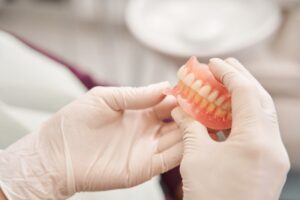
Dentures have come a long way from their humble beginnings. What once were rudimentary attempts to replace missing teeth have evolved into sophisticated, natural-looking dental solutions that restore function, confidence, and quality of life. The evolution of dentures over the years is a fascinating story of innovation, science, and a commitment to improving oral health.
Ancient Origins
The earliest versions of dentures date back thousands of years. In ancient civilizations such as Egypt and Etruria (modern-day Italy), people used materials like human or animal teeth, bone, and ivory to create primitive dental prosthetics. These were often tied together with metal wire or gold bands and were primarily available to the wealthy elite. They offered limited function and were mostly cosmetic.
The Wooden Dentures of Japan
In 16th century Japan, dentures carved entirely from wood became relatively common. These wooden dentures were molded to fit the mouth and often featured a surprisingly accurate fit for the era. While not particularly durable or comfortable, they represented a significant step toward custom-made dental prosthetics.
18th Century Innovations
By the 1700s, dentures began to evolve more rapidly in Europe. One notable advancement was the use of human teeth, often sourced from the deceased or poor individuals, to create full or partial dentures. These “real” teeth were set into ivory bases and could be quite expensive. However, they were prone to decay and often carried hygienic risks.
One of the most famous wearers of dentures during this period was George Washington. Contrary to popular myth, his dentures were not made of wood but of materials like ivory, gold, and lead, with human and animal teeth attached.
The Birth of Modern Dentures
The 19th century saw major strides in denture technology. The invention of vulcanized rubber in the 1850s allowed for a more affordable and moldable base material. Vulcanite, a type of hardened rubber, became the standard for denture bases, making them more accessible to the general public. Porcelain teeth began replacing natural ones, offering better aesthetics and hygiene.
20th-Century Advancements
With the rise of acrylic resins and plastics in the 20th century, dentures became even more lightweight, durable, and lifelike. These materials allowed for greater customization, improved comfort, and better appearance. Advances in dental impressions and modeling techniques meant dentures could be fitted more precisely to individual mouths.
The introduction of implant-supported dentures in the late 20th century revolutionized the field even further. These dentures are anchored to dental implants surgically placed in the jawbone, providing a secure, natural-feeling alternative to traditional removable dentures.
Dentures Today
Today’s dentures are a far cry from their ancient counterparts. Modern dentures are crafted using digital imaging, 3D printing, and high-tech materials that mimic the look and feel of real teeth. They offer improved fit, enhanced durability, and superior aesthetics. Patients can now choose from full, partial, and implant-supported options tailored to their specific needs.
The journey of dentures from carved wood and ivory to today’s cutting-edge prosthetics is a testament to human ingenuity and the desire to improve lives. As dental technology continues to advance, the future of dentures looks even brighter, promising even more natural, comfortable, and effective solutions for tooth loss.
About the Practice
At Cambria Smiles, we can restore your look and functionality with partial and full dentures specially designed for each individual patient. They’re made to look great, fit comfortably, and last a lifetime. We also have removable and implant-retained dentures available! If you’re ready to get your smile back, call our office at (805) 927-4811 or visit our website.


